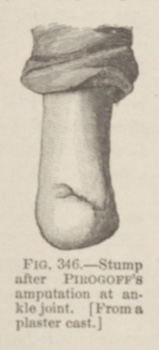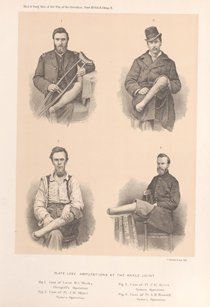Title: Weeks, W. C.
Source text: The Medical and Surgical History of the War of the Rebellion. (1861-65.), Part 3, Volume 2 (Washington, DC: Government Printing Office, 1883), 597-598, 597, 596-597.
Civil War Washington ID: med.d2e23037
TEI/XML: med.d2e23037.xml
CASE 873.—Lieutenant W. C. Weeks,² Co. I, 5th Michigan Cavalry, aged 28 years, was wounded at Five Forks, April 1, 1865, by a conoidal musket ball, which passed through the left ankle joint. Assistant Surgeon C. A. Leale, U. S. V., reported: "He was immediately conveyed to hospital at City Point, where Surgeon A. K. St. Clair, 5th Michigan Cavalry, performed Pirogoff's amputation at the ankle joint the same day, removing the articulating surfaces of the tibia and calcaneum and bringing the cut extremities into apposition. On April 16th the patient was transferred to Armory Square Hospital at Washington, where he was admitted in a very feeble condition. Erysipelatous inflammation extended from the stump several inches above the knee joint. Extensive suppuration had taken place, and, although fifteen days had elapsed since the operation, the rough edges of the calcaneum could be rubbed against the denuded end of the tibia, proving that no union existed. The integumentary flap had partially united, thus confining a large quantity of pus in the stump, which prevented the bones from being kept in apposition. Metastatic abscesses had commenced to form along the course of the anterior tibial lymphatic glands, and every symptom prognosticated an unfavorable termination, the only hope being based on the remarkable strong constitution of the patient. The abscess at the stump was freely evacuated, and the metastatic abscesses were freely opened as soon as fluctuation could be detected; the calcaneum and tibia were held in proper position by means of adhesive straps after the limb had been thoroughly cleansed with liquor of chloride of zinc. Large linseed poultices were applied over the lower third of the tibia and lead and opium wash over the remaining part of the limb as far as the erysipelas extended; stimulants and beef tea were administered. The patient gradually improved until April 28th, when he had a chill, which was soon followed by others. Quinine and tincture of chloride of iron was then prescribed and an ounce of brandy was given every two hours. By May 2d the patient had the peculiar sweet odor of breath and the well-marked icteroid hue, especially in the conjunctivæ, which were exceedingly yellow. Several chills occurred each day and were followed by considerable febrile movement and great prostration; but by the frequent administration of stimulants and the constant application of artificial heat the patient rallied, after which beef tea was given in quantities as large as could be tolerated. From May 6th he improved, the chills occurring at longer intervals and with less severity until May 12th, when they ceased. A slight diarrhœa at this time was checked by starch and opium injections, after which the patient convalesced rapidly. By June 26th he had entirely recovered, the os calcis having united to the tibia and the wound having closed, leaving a solid, firm stump." A plaster cast of the stump, Specimen 2298 of the Army Medical Museum, is shown in FIG. 346, and a photograph of the patient is copied in FIGURE I of PLATE LXXV, opposite page 596. Lieutenant Weeks was mustered out of service July 20, 1865, and pensioned, after which time he commenced to wear the "Palmer" artificial foot. In a subsequent report, dated June 28, 1866, Dr. Leale furnished the following information in regard to the case: "I have just received a communication from Lieutenant Weeks (residing at Allegan, Michigan), in which he states: 'I am able to do anything that most men can do; my patent foot works like a charm. I am at present engaged in a large flour mill, and my stump has never troubled me but once since I left the hospital, and then it was caused by an accident, which loosened a small splinter of bone. This I had removed at Chicago, since which time it has done well. I adjusted my false foot on October 1, 1865, and never take it off except when I go to sleep. I can easily walk without a cane.'" The pensioner was paid September 4, 1881.
² Circular No. 6, War Department, S. G. O., 1865, p. 47. SMITH (S.), Amputations at the Ankle Joint in Military Surgery, in U. S. Sanitary Commission Memoirs, New York, 1871, Surgical Volume II, p. 116, 132.

